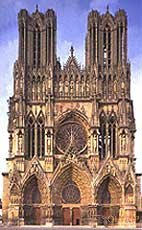
Gothic style (from Italian. Gotico, letters. - Gothic, from the name of the Germanic tribe is ready), artistic style, which was the final stage in the development of medieval art of the countries of Western, Central and Eastern Europe (between the mid 12th and 15th - 16th centuries).  The term "Gothic" was introduced in the Renaissance as a derogatory designation of all medieval art, which was considered "barbaric". From the beginning of the 19th century, when for the art of the 10th - 12th centuries. the term Romanesque was adopted, the chronological framework of the Gothic style was limited, it identified the early, mature (high) and late phases. Gothic developed in countries dominated by the Catholic Church, and under its auspices of the feudal church foundations remained in the ideology and culture of the Gothic era. Gothic art remained predominantly religious and religious in its themes: it was correlated with eternity, with the "highest" irrational forces. For the Gothic, characterized by symbolic-allegorical type of thinking and the conventionality of artistic language. From the Romanesque Gothic style inherited the primacy of architecture in the arts and traditional types of buildings.
The term "Gothic" was introduced in the Renaissance as a derogatory designation of all medieval art, which was considered "barbaric". From the beginning of the 19th century, when for the art of the 10th - 12th centuries. the term Romanesque was adopted, the chronological framework of the Gothic style was limited, it identified the early, mature (high) and late phases. Gothic developed in countries dominated by the Catholic Church, and under its auspices of the feudal church foundations remained in the ideology and culture of the Gothic era. Gothic art remained predominantly religious and religious in its themes: it was correlated with eternity, with the "highest" irrational forces. For the Gothic, characterized by symbolic-allegorical type of thinking and the conventionality of artistic language. From the Romanesque Gothic style inherited the primacy of architecture in the arts and traditional types of buildings. 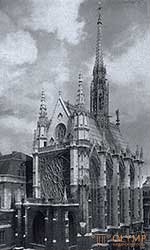 A special place in the art of Gothic took the cathedral - the highest example of the synthesis of architecture, sculpture and painting (mainly stained glass). The space of the cathedral, incommensurable with man, the verticalism of its towers and vaults, the subordination of sculpture to dynamic architectural rhythms, and the multi-colored radiance of stained glass windows had a strong emotional impact on believers.
A special place in the art of Gothic took the cathedral - the highest example of the synthesis of architecture, sculpture and painting (mainly stained glass). The space of the cathedral, incommensurable with man, the verticalism of its towers and vaults, the subordination of sculpture to dynamic architectural rhythms, and the multi-colored radiance of stained glass windows had a strong emotional impact on believers.
The development of Gothic art reflected the dramatic changes in the structure of medieval society: the beginning of the formation of centralized states, the growth and strengthening of cities, the nomination of secular forces - urban, commercial and handicraft, as well as court and knight circles. With the development of social consciousness, crafts and technology weakened the foundations of the medieval religious and dogmatic worldview, the possibilities of cognition and aesthetic understanding of the real world expanded; emerging new architectural types and tectonic systems. Intensive development of urban planning and civil architecture. Urban architectural ensembles included religious and secular buildings, fortifications, bridges, and wells. 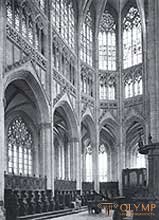 The main town square was often surrounded by houses with arcades, retail and warehouse premises in the lower floors. Main streets diverged from the square; narrow facades of 2-, less often 3-storey houses with high gables lined up along streets and embankments. Cities were surrounded by powerful walls with ornate travel towers. Castles of kings and feudal lords gradually turned into complex complexes of serfs, palaces and religious buildings. Usually in the center of the city, dominating its buildings, there was a castle or a cathedral, which became the focus of city life. In it, along with the divine service, theological disputes were organized, mysteries were played out, meetings of citizens took place. The cathedral was thought of as a kind of knowledge, a symbol of the Universe, and its artistic structure, combining solemn majesty with passionate dynamics, an abundance of plastic motifs with a strict hierarchical system of their subordination, expressed not only the ideas of the medieval social hierarchy and power but also the growing self-consciousness of citizens, the creative grandeur of efforts human collective.
The main town square was often surrounded by houses with arcades, retail and warehouse premises in the lower floors. Main streets diverged from the square; narrow facades of 2-, less often 3-storey houses with high gables lined up along streets and embankments. Cities were surrounded by powerful walls with ornate travel towers. Castles of kings and feudal lords gradually turned into complex complexes of serfs, palaces and religious buildings. Usually in the center of the city, dominating its buildings, there was a castle or a cathedral, which became the focus of city life. In it, along with the divine service, theological disputes were organized, mysteries were played out, meetings of citizens took place. The cathedral was thought of as a kind of knowledge, a symbol of the Universe, and its artistic structure, combining solemn majesty with passionate dynamics, an abundance of plastic motifs with a strict hierarchical system of their subordination, expressed not only the ideas of the medieval social hierarchy and power but also the growing self-consciousness of citizens, the creative grandeur of efforts human collective.
The bold and complex frame construction of the Gothic cathedral, which embodied the triumph of man’s bold engineering thought, made it possible to overcome the massiveness of Romanesque structures, to facilitate the walls and vaults, to create a dynamic unity of the inner space. 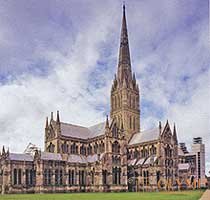 In Gothic, there is an enrichment and complication of the synthesis of arts, the expansion of the system of plots, which reflected the medieval ideas about the world. The main type of visual art was sculpture, which received a rich ideological and artistic content and developed plastic forms. The stasis and closeness of the Romanesque statues were replaced by the mobility of the figures, their appeal to each other and to the viewer. There was an interest in real natural forms, in the physical beauty and feelings of man, a new interpretation was given to the themes of motherhood, moral suffering, martyrdom and human sacrifice. In Gothic lyricism and tragic affects organically intertwined, sublime spirituality and social satire, fantastic grotesque and folklore, acute life observations. In the epoch of Gothic, a miniature of books flourished and altar painting appeared, decorative art reached a high rise, associated with a high level of development of craft craft.
In Gothic, there is an enrichment and complication of the synthesis of arts, the expansion of the system of plots, which reflected the medieval ideas about the world. The main type of visual art was sculpture, which received a rich ideological and artistic content and developed plastic forms. The stasis and closeness of the Romanesque statues were replaced by the mobility of the figures, their appeal to each other and to the viewer. There was an interest in real natural forms, in the physical beauty and feelings of man, a new interpretation was given to the themes of motherhood, moral suffering, martyrdom and human sacrifice. In Gothic lyricism and tragic affects organically intertwined, sublime spirituality and social satire, fantastic grotesque and folklore, acute life observations. In the epoch of Gothic, a miniature of books flourished and altar painting appeared, decorative art reached a high rise, associated with a high level of development of craft craft. 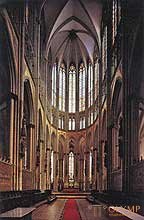 divine powers over man
divine powers over man
Gothic was born in Northern France (Ile-de-France) in the middle of the 12th century. and reached its heyday in the 1st half of the 13th century. Stone Gothic cathedrals in France received its classical form. As a rule, these are 3-5-nave basilicas with a transverse nave — a transept and a semicircular round of the choir (“deambulatory”), to which are attached radial chapels (“crown cap”). Their high and spacious interior is illuminated by the color shimmer of stained glass windows. The impression of uncontrollable movement upwards and towards the altar is created by rows of slender pillars, a powerful take-off of pointed pointed arches, and an accelerated rhythm of the arcades of the upper gallery (triforium). Due to the contrast of the high main and semi-dark side aisles, a picturesque richness of aspects arises, a feeling of infinity of space. The constructive basis of the cathedral is a frame of pillars (in a mature Gothic style - a bunch of columns) and lancet arches resting on them. The structure of the building consists of rectangular cells (grass), bounded by 4 pillars and 4 arches, which, together with arch-ribs, form the skeleton of the cross vault, filled with lightweight small vaults - formwork. The lateral spreading of the roof of the main nave is transmitted by means of supporting arches (arkbutans) to the outer pillars — buttresses. Freed from the walls in the gaps between the pillars are cut through arched windows. Neutralization of the arch of the arch by bringing out the main structural elements made it possible to create a feeling of lightness and spatial freedom of the interior. 2-tower western facades of French cathedrals with 3 "promising" portals and a patterned round window 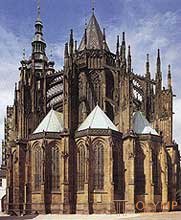 ("rose") in the center combine striving upwards with a clear balance of division. The facades vary lancet arches and rich architectural, plastic and decorative details - patterned vimpergi, phials, crabs, etc. Statues on consoles in front of columns of portals and in their upper arched gallery, portals and timpans of portals, as well as on capitals columns form a coherent story system, which includes the characters and episodes of Scripture, applegorical images. The best works of Gothic plastics - the statues of the facades of the cathedrals at Chartres, Reims, Amiens, and Strasbourg are imbued with spiritualized beauty, sincerity, and noble feelings. The decor is rhythmically organized and strictly subordinated to the architectural divisions of the facade, which resulted in a harmonious tectonics and proportions of the statues, the solemnity of their poses and gestures. Other parts of the temples were also decorated with reliefs, statues, floral ornaments, images of fantastic animals; characteristic abundance in the decor of secular motifs (scenes of labor of artisans and peasants, grotesque and satirical images). The subjects of stained glass windows, in the gamut of which red, blue and yellow tones prevailed, are also varied.
("rose") in the center combine striving upwards with a clear balance of division. The facades vary lancet arches and rich architectural, plastic and decorative details - patterned vimpergi, phials, crabs, etc. Statues on consoles in front of columns of portals and in their upper arched gallery, portals and timpans of portals, as well as on capitals columns form a coherent story system, which includes the characters and episodes of Scripture, applegorical images. The best works of Gothic plastics - the statues of the facades of the cathedrals at Chartres, Reims, Amiens, and Strasbourg are imbued with spiritualized beauty, sincerity, and noble feelings. The decor is rhythmically organized and strictly subordinated to the architectural divisions of the facade, which resulted in a harmonious tectonics and proportions of the statues, the solemnity of their poses and gestures. Other parts of the temples were also decorated with reliefs, statues, floral ornaments, images of fantastic animals; characteristic abundance in the decor of secular motifs (scenes of labor of artisans and peasants, grotesque and satirical images). The subjects of stained glass windows, in the gamut of which red, blue and yellow tones prevailed, are also varied.
The prevailing Gothic frame system appeared in the church of Saint-Denis Abbey (1137–44). The cathedrals in Lahn, Paris, Chartres also belong to the early Gothic. Riches rhythm 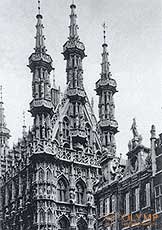 The perfection of the architectural composition and the sculptural decoration is distinguished by the grandiose cathedrals of the mature Gothic in Reims and Amiens, as well as the chapel of Saint-Chapelle in Paris (1243-48) with numerous stained glass windows. From the middle of the 13th century majestic cathedrals were built in ancient European countries — in Germany (in Cologne), the Netherlands (in Utrecht), Spain (in Burgos, 1221—1599), Great Britain (Westminster Abbey in London), Sweden (in Uppsala), the Czech Republic (choir and transept St. Vitus Cathedral in Prague), where the Gothic building techniques received a kind of local interpretation. The Crusaders brought the principles of Gothic to Rhodes, Cyprus and Syria.
The perfection of the architectural composition and the sculptural decoration is distinguished by the grandiose cathedrals of the mature Gothic in Reims and Amiens, as well as the chapel of Saint-Chapelle in Paris (1243-48) with numerous stained glass windows. From the middle of the 13th century majestic cathedrals were built in ancient European countries — in Germany (in Cologne), the Netherlands (in Utrecht), Spain (in Burgos, 1221—1599), Great Britain (Westminster Abbey in London), Sweden (in Uppsala), the Czech Republic (choir and transept St. Vitus Cathedral in Prague), where the Gothic building techniques received a kind of local interpretation. The Crusaders brought the principles of Gothic to Rhodes, Cyprus and Syria.
In the late 13th - early 14th centuries. the construction of cathedrals in France was in crisis: the architectural forms became drier, the decor was more abundant, the statues received the same underlined S-shaped bend and courtesy features. From the 14th century great importance acquired urban and monastic hall churches, castle and palace chapels. The late (“flaming”) Gothic is characterized by a capricious window-like pattern resembling flames (Saint-Macloo church in Rouen). In secular urban architecture, mainly Gothic compositions and decorative techniques were used. On the main square of the city built the town hall with a rich decor, often with a tower (Town Hall in Saint-Quentin, 1351-1509). The castles were transformed into stately palaces with rich interiors (the papal palace complex in Avignon), mansions ("hotels") of wealthy citizens were built.
In the late Gothic, sculptural altars in the interiors became widespread, combining wooden painted and gilded sculpture and tempera painting on wooden boards. A new emotional structure of images has emerged, featuring dramatic (often exalted) expression, especially in scenes of the sufferings of Christ and the saints, transmitted with merciless truthfulness. There were paintings on secular subjects (in the papal palace in Avignon, 14-15 centuries). In miniatures (watchwords) there was a desire for the spiritualized humanity of images, for the transfer of space and volume. Among the best examples of French Gothic decorative art are small ivory sculpture, silver reliquaries, Limoges enamel, tapestries and carved furniture.
In Germany, the flowering of Gothic art dates back to the mid-13th century. (Western Choir of the Cathedral in Naumburg). Hall halls of churches appeared here early (Elizabethkirche in Marburg, 1235–83); in the south-west there was a type of 1-tower cathedral (in Freiburg-in-Breisgau, Ulm); brick churches were built (a monastery in Corin, 1275–1334; the Marienkirche in Lübeck), in which simplicity of plans, volumes and structures were combined with patterned masonry, the use of glazed and shaped brick. Stone, brick and half-timbered secular buildings (city gates, town halls, workshop and storage buildings, dance halls) are diverse in type, composition and decor. The sculpture of the cathedrals (in Bamberg, Magdeburg, Naumburg) is distinguished by the concreteness and monumentality of images, powerful ppastic expression. Late German Gothic (late 14th – early 16th centuries) gave brilliant examples of hall churches (Annenkirche in Annaberg-Buchholz, 1499-1525) and palace halls (Albrechtsburg in Meissen) with intricate patterns of vaults. The altar sculpture and painting reached its peak. Gothic was also spread in Austria (the Gothic part of the Cathedral of St. Stephen in Vienna) and Switzerland (the Cathedral in Bern).
The glory of the Netherlands Gothic brought the towers of the cathedrals in Antwerp and Mechelen, but especially richly decorated civil buildings (cloth rows in Ypres, 1200-1304, Bruges; town hall in Brussels, Leuven).
In Great Britain, the preconditions of the Gothic originated earlier than on the European continent, but its development, which was interrupted by internal historical shocks, was slow. English cathedrals, mostly monastic, usually represent a low, elongated volume with a rectangular end of the choir and a tower above the center of the cross. The strict geometric simplicity of the volumes is, as it were, compensated for by the richness and complexity of the patterns on the facade and vaults. 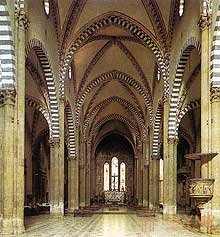 The forms of decor distinguish styles: early ("lanceolate"; the Cathedral in Salisbury), "decorated" (close to the "flaming" Gothic (Exeter Cathedral, between 1275-1375) and "perpendicular", characterized by a fractional rhythm of verticals on the walls and windows and whimsical weaving of ribs on arches and ceilings (Kings College, Cambridge, 1446-1515). English literary miniatures, alabaster and wood carving, embroidery are associated with Gothic. The influence of English, French and German brick gothic influenced Gothic architecture. (cathedral in Trondheim, g otic parts — 1180–1320), Denmark (St. Knud's Cathedral in Odense, about 1300–15), Sweden (Wadsten Church, 1369–1430).
The forms of decor distinguish styles: early ("lanceolate"; the Cathedral in Salisbury), "decorated" (close to the "flaming" Gothic (Exeter Cathedral, between 1275-1375) and "perpendicular", characterized by a fractional rhythm of verticals on the walls and windows and whimsical weaving of ribs on arches and ceilings (Kings College, Cambridge, 1446-1515). English literary miniatures, alabaster and wood carving, embroidery are associated with Gothic. The influence of English, French and German brick gothic influenced Gothic architecture. (cathedral in Trondheim, g otic parts — 1180–1320), Denmark (St. Knud's Cathedral in Odense, about 1300–15), Sweden (Wadsten Church, 1369–1430).
In Spain, the extensive city cathedrals (in Seville) were usually clearly divided by the decor on the tiers of the plane of the walls and small windows. The interior was divided in two in the altar way (retable) with sculpture and painting. Moorish art influenced the Gothic architecture of Catalonia and Southern Spain (1-nave late Gothic cathedral in Gerona, 1325–1607). Large vaulted halls were created in secular buildings (Palma Stock Exchange on Mallorca Island, 1426–51). In the 16th century Gothic constructions were transferred to the Spanish colonies in America.
In Italy in the 13th and 14th centuries. Gothic elements were included in the Romanesque architecture of temples. Lancet Gothic arches and decor were combined with static architectural masses, proportional clarity of spacious interiors, polychrome marble facing of facades and interiors (the cathedral in Siena, the church of Santa Maria Novella in Florence). The most gothic in Italy was manifested in civil engineering - the town halls (Palazzo Publico in Siena, Palazzo del Podesta in Florence) and palaces (Doge's Palace in Venice). Their harsh (in Siena, Florence) or elegant (in Venice) decor contrasted with the monolithic masonry of the walls. The impact of the Venetian Gothic influenced the architecture of Dalmatia (Croatia), Greece, Crete, Cyprus. In the art of Italy, the development of Gothic art was limited to the early addition of the Renaissance culture. Gothic buildings of Eastern Europe are often characterized by serf features, conciseness and external severity of forms, contrasting with the elegant decoration of windows, towers, portals. In Hungary, the Gothic spread in the late 13th and 15th centuries. (the Church of St. Michael in Sopron, the castle in Visegrad). The heyday of Czech Gothic dates back to the 14th and 15th centuries. (St. Vitus Cathedral and Charles Bridge in Prague, hall temple of St. Barbara in Kut-na-Gore, hall churches of South Bohemia). Gothic spread in Slovakia, Slovenia, Transylvania. In Poland, the Gothic style developed in the 13th and 15th centuries. The wars with the Teutonic Order stimulated serf construction, and the development of cities contributed to the flourishing of secular architecture (the town hall in Torun, the city fortifications with barbakanas in Krakow and Warsaw. Yagiellonian University in Krakow). In the south of Poland, churches were built of stone and brick (Church of Our Lady in Krakow), in the north - of brick (Church of Our Lady in Gdansk). In Latvia, the transition to the Gothic style took place in the 13th and 14th centuries. (Dome church in Riga; castle in Cesis, 13-16 centuries). In southern Estonia in the 14th century brick Gothic churches were built (Jaani Church in Tartu). Gothic appearance of Tallinn was determined in the 14-15 centuries. (Vyshgorod and the burgher part of the city with the town hall, the Church of Oleviste). By the 14th and 15th centuries. include the early Gothic monuments of Lithuania (the castle in Trakai), in the 15th and 16th centuries. Onos ’church in Vilnius and Perkuno’s house in Kaunas receive rich brick décor.
In the Late Gothic era, the accumulation of empirical knowledge, the growing interest in reality, in observing and studying nature, and the increased role of creative individuality set the stage for the Renaissance worldview system. This process was manifested in the 14 — early. 16th century in the French and Burgundian miniatures, in sculpture (Klaus Sluter) and painting (Melchior Bruderlam, etc.) German, Czech. Polish decorative plastics (Peter Parler), in altar sculpture and painting (master Theodorik, etc.). In 15 - 16 centuries. he was accelerated by the influence of the Italian and Dutch Renaissance. For 16 c. Gothic almost universally replaced by Renaissance culture.
Что бы оставить комментарий войдите
Комментарии (0)